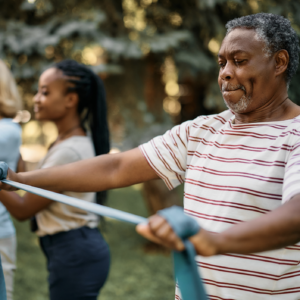Athletic Achievement: What Is Exercise Doing For Your Brain And Body?

Athletic Achievement: What Is Exercise Doing For Your Brain And Body?
September 27, 2023
By now you probably know that exercise is an essential component of healthy aging: You simply must move your body on a consistent and regular basis to support both physical, cognitive, and emotional health and well-being. As we’ve said time and again, both aerobic exercise, to get your heart pumping and your skin sweating, along with resistance and strength training, are recommended as essential components of a good exercise routine as you get older. In fact, for adults 65 and older and for those who have chronic disease or disabilities the CDC recommends at least 150 minutes a week of moderate-intensity aerobic activity and at least 2 days a week of muscle-strengthening activities. For some specific ideas of how you can spend those minutes in exercise, take a look at some sample exercise schedules from the CDC here.
However, a recent survey from AARP and NORC at the University of Chicago underscores that not everyone is on board with these exercise recommendations. According to this survey, only ⅓ of adults aged 50 and older are aware of these suggestions, and even fewer- 23%- report following these exercise recommendations. That means a large percentage of older adults are losing out on a surefire way to help maintain and support their health as they age. However, the survey reports that over 90% of those who say they follow the exercise recommendations are satisfied with their overall health as compared to only 67% of those who do not follow such guidance.
It’s not only clear that exercise can bring about more positive feelings about health and aging, but new research once again underscores the value of an exercise program, particularly when it comes to brain health. For example, a recent study published in the journal GeroScience found that among the participants, who were 85 and older, there was a correlation between those who engaged in both aerobic and strength training exercises and better performance on cognitive tests, compared to those who were sedentary or didn’t engage in physical exercise. So file that under “you’re never too old” and take a look here. Another new study, this one out of Mass General Hospital and published in the journal Neuron, found that exercise helps to increase the production of the hormone irisin (which we’ve previously discussed) and irisin is linked to reducing the amount of amyloid beta in the brains of those with Alzheimer’s. While we don’t yet know exactly what kind of exercise can be most helpful and for how long you’d need to exercise in order to produce this result, it once again links exercise engagement with better brain health. So put on some walking shoes and read more here.
While it’s very clear that exercise is essential for healthy aging, sometimes a little new inspiration can help get you going, especially if you’ve “fallen off the horse,” so to speak. For an energetic walking routine that will get your heart pumping, watch here. And for some strength and resistance training inspiration that really requires nothing more than a resistance band (and maybe a small foam mat for your butt), stretch your arms wide and watch here.







